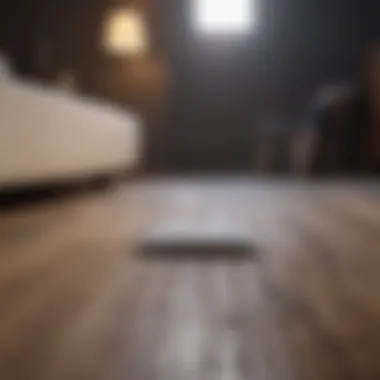Impact of Floor Sleeping on Back Health and Wellbeing


Intro
Sleeping has always been a fundamental aspect of human life. It’s often said you reap what you sow, particularly when it comes to rest. The environment in which one sleeps can affect overall health more than many realize. The idea of sleeping on the floor, stripped of modern comforts, might sound foreign to some, yet it has historical roots and cultural significance in various parts of the world. In this article, we aim to dissect the implications of this practice on back health. By weaving together expert insights, medical perspectives, and anecdotal narratives, we will explore the nuances and help individuals navigate informed decisions about their sleep space.
Key Benefits
Adopting a floor-sleeping practice can usher in a few distinct advantages, garnering attention from wellness professionals and health enthusiasts alike. While the transition may be jarring initially, understanding what benefits might come from this approach can aid in fostering a more adventurous outlook toward sleep.
Physical Health Benefits
When it comes to physical health, the floor offers a flatter, more stable sleeping surface, which can potentially improve spinal alignment. Here are some insightful points to consider:
- Spinal Alignment: The hard surface of the floor allows the body to rest in a more neutral position, which could alleviate pressure on the spine during sleep.
- Muscle Recovery: Some individuals claim that sleeping in such a manner fosters better muscle recovery, as it potentially enhances circulation and reduces stiffness.
- Force Distribution: Sleeping on a firm surface could theoretically help distribute body weight more evenly and prevent sinking into softer bedding that can exaggerate spinal misalignment.
Mental Well-being Enhancements
Floor sleeping isn't just a matter of physical comfort; it can also tap into mental wellness.
- Simplification of Space: Sleeping on a floor may encourage simplicity, promoting a minimalist lifestyle that resonates with decluttering mental space as well.
- Mindfulness Practice: The experience of lying directly on the floor can serve as a grounding technique, encouraging one to be present and aware of their body.
- Cultural Perspectives: Engaging with practices from various cultures can foster connection and appreciation, enriching the mind by exploring alternatives to what's normative.
"Exploring unconventional sleep methods can reshape not just our physical habits, but also our psychological frameworks."
Caveats and Considerations
Despite the advantages, it's vital to recognize that each person's body is unique. What could be beneficial for one individual might lead to discomfort for another. People who wrestle with chronic pain or certain medical conditions should consult with a healthcare professional before making any drastic changes to sleep environments. Listening to one’s body is key to finding what feels nourishing.
This exploration raises a question—can the floor become a sanctuary for better sleep health? While the advantages are notable, incorporating mindful adjustments ensures a personalized approach to sleep hygiene. In the next sections, we will delve deeper into practical methods to harmonize floor sleeping with a healthy lifestyle and additional suggestions to transition effectively.
Foreword to Sleep Positions and Back Health
The way we sleep can have a significant impact on back health, one that is often overlooked. While pillows and mattresses often take centerstage in discussions about sleep, the surface you lay on—specifically, whether it's a bed or the floor—can also play a crucial role. Understanding the relationship between sleep positions and spinal health helps individuals make informed choices about their sleep environment. This article will delve into various aspects of sleep positioning, and in particular, the practice of floor sleeping.
The Role of Sleep in Overall Wellness
Sleep is not just a time for the body to rest; it's a vital component of overall wellness. Adequate sleep allows our bodies to recover and promote growth, and it plays an essential role in cognitive functions, emotional health, and immune response. Not enough sleep can lead to a myriad of issues ranging from irritability to chronic illnesses.
Many people aren’t aware that the quality of sleep depends heavily on sleep position. When you sleep, your body goes through various stages, primarily involving REM and non-REM sleep. Each position can influence how well you transition through these cycles. For instance, sleeping on your back can help maintain a neutral spine position, potentially reducing the chances of waking up with aches and pains.
In contrast, side sleeping can provide benefits as well, but with certain complications, particularly regarding shoulder and hip pressure. The debates continue in the health community about the best sleep position for back health. In some cultures, floor sleeping is a norm—often regarded as a pathway to better posture and body alignment.
Understanding Spinal Alignment During Sleep
Spinal alignment during sleep is paramount for preventing discomfort and injuries. A neutral spine is when your head, shoulders, and hips are all aligned. It’s often said that when the spine is well-aligned, it reduces strain on the muscles and ligaments, leading to a more restorative sleep experience.
When you sleep against a firm surface, like the floor, some believe that the body might align more naturally because it descends into its organic rest position. However, this sensation of alignment varies from person to person, influenced by factors like body weight and natural curvature of the spine.
"Spinal health starts with understanding how the body naturally wants to rest—floor sleeping can either enhance or disrupt that understanding."
Cushioning and support can drastically differ in various sleeping environments. For some, a hard floor may provide the right amount of feedback for their backs; for others, it could invite discomfort. It’s about finding what works best for the individual.
In this article, we will explore the cultural perspectives, benefits, risks, expert opinions, and anatomy factors related to floor sleeping and its influence on back health. The aim is to offer a comprehensive insight that combines traditional practices with modern findings, ultimately guiding readers to make more knowledgeable decisions regarding their sleep arrangements.
Cultural Perspectives on Sleeping Surfaces
The way people sleep often depends on their culture, and this influences the sleeping surfaces they choose. Cultural perspectives on sleeping surfaces forge a rich tapestry connecting tradition, health, and lifestyle. By exploring these perspectives, we can better appreciate why sleeping on the floor may be beneficial and how it aligns with various cultural practices. Moreover, understanding these elements can guide individuals in making adaptations that reflect their well-being needs.
Traditional Practices Around the World
In many cultures, sleeping on the floor has long been the norm. In Japan, for example, tatami mats made from rice straw serve as traditional bedding surfaces. They promote a firm sleeping area that supports posture while also allowing for easy air circulation. In this context, sleeping directly on the floor aligns with the cultural ethos of minimalism and harmony with nature.
In some areas of India, the practice of sleeping on the floor is rooted in Ayurvedic principles. Many believe that sleeping on a firm, flat surface aids in maintaining spinal alignment and improves energy flow. Additionally, communities in Mongolia often utilize felt-covered yurts, sleeping on mats made from sheep's wool spread across the earth floor, reinforcing the connection with the land and traditional nomadic living.


"Culture shapes the way we perceive comfort and health in our sleeping environments. "
These traditional practices highlight a broader variety of approaches to sleeping surfaces. Whether it be the materials used or the positioning of the body, each culture offers insights into how firm sleeping might not be a trend but instead a well-established choice backed by centuries of practice.
Modern Adaptations and Influences
In recent years, there’s been a resurgence of interest in traditional sleeping practices, including floor sleeping. Many have begun to reconsider their approach to sleep in light of contemporary health trends that emphasize minimalism and natural materials. For instance, floor sleeping has been embraced by some segments of the wellness community, seen as a way to reconnect with the body’s natural state.
Moreover, urban living has catalyzed a shift towards floor sleeping as individuals navigate space constraints. With smaller living areas, the need for multifunctional living environments emerges. Folding futons or thin mattresses are easily stored away, transforming a living area into a sleeping space with little fuss.
While cultural practices emphasize the benefits of firmer surfaces, modern mattresses often cater to comfort over support, leading many to experience discomfort or poor spinal alignment.
To sum it up, cultural and modern perspectives on sleeping surfaces showcase a fascinating interplay between tradition and contemporary living. As more individuals explore alternative sleep solutions, understanding these varying practices offers valuable insight into how sleeping on the floor may align perfectly with personal health goals.
Through tradition and modification, it becomes clearer that the choice of sleeping surface has long-lasting implications for well-being.
Potential Benefits of Sleeping on the Floor
Sleeping on the floor might seem a bit unconventional, but it brings a set of benefits worth exploring, especially when considering back health. Many people find themselves questioning their sleep surfaces, feeling discomfort or unrest on soft mattresses. This section seeks to detail specific benefits that can potentially arise from a floor-sleeping practice.
Enhanced Spinal Support
One of the consistent advantages championed by floor sleeping proponents is enhanced spinal support. Unlike the plush feel of traditional mattresses, sleeping on a firmer surface encourages better alignment of the spine. This can mitigate the common issues many face, like chronic back pain or discomfort.
When you lie on the floor, your body is less likely to sink into a soft mattress, which can cause the spine to curve unnaturally. Rather, the firm surface promotes a neutral spine position, which is essential for those who suffer from various spinal ailments.
The key benefits can be summarized as follows:
- Supportive Alignment: Firm surfaces promote alignment, keeping the spine in a straight line.
- Muscle Relief: Muscles are less likely to tense up due to the even pressure distribution across the back.
- Reduced Pain: Many findings suggest that individuals with certain back issues report reduced pain after transitioning to floor sleeping.
Incorporating this practice into one’s routine could shift the way individuals perceive their sleep health altogether. It might be time to reconsider traditional notions of comfort, focusing instead on the long-term benefits of spinal health.
Increased Grounding and Connection
Another point to reflect upon is the idea of grounding—a term gaining traction in discussions about wellness. Grounding, or earthing, involves direct physical contact with the earth, which some believe contributes to improved health outcomes. When sleeping on the floor, individuals may experience not only physical but also mental benefits tied to this practice.
Many assert that reconnecting with the earth, through floor sleeping, promotes a sense of calm. The theory is based on the premise that this connection helps to reduce inflammation, improve sleep quality, and even stabilize emotional well-being.
Some noteworthy aspects include:
- Restorative Effects: Grounding is thought to restore balance in one’s body, which can be especially helpful for those under stress.
- Increased Awareness: Being closer to the ground might encourage mindfulness and a deeper awareness of one’s body position and tension.
- Natural Environment Connection: People often feel more in tune with nature when engaging in practices perceived to be more natural, such as floor sleeping.
"Connecting with the earth might just be a way to allow the body to reset and recharge."
Each of these benefits underscores a more holistic approach to health focusing not just on physiological aspects but also on mental and emotional support. While it might take a bit of getting used to, the potential health returns from sleeping on the floor may well make the transition worthwhile.
Examining Potential Risks of Floor Sleeping
When discussing the subject of floor sleeping, it becomes crucial to shine a light on its potential risks. While it holds appeal for some due to its back-supportive nature and cultural significance, there are underlying factors that might not be as benign. Understanding these risks can offer a well-rounded perspective that helps individuals decide whether to take the leap into floor sleeping or stick with their current arrangements.
Discomfort and Sleep Disruption
One of the more immediate concerns that often gets raised about sleeping on the floor is the discomfort that many individuals experience. The rigid surface tends to be an adjustment for those used to softer mattresses. Not only does it pose a challenge for the unaccustomed back, but it can also lead to irritability throughout the night. Let’s unpack this further.
- Personal Comfort Levels: Individuals seeking comfort while sleeping often rely on the cushioning of traditional mattresses. Conversely, the unforgiving nature of the floor can cause stress points, especially around the shoulder and hip area.
- Sleep Quality: Discomfort can lead to tossing and turning, preventing the achievement of deeper sleep stages. This disruption can spiral into fatigue during the day, affecting one’s concentration and overall mood.
- Injury Risk: An unyielding sleeping surface can occasionally lead to strains or aches, particularly for individuals already dealing with back problems. If proper spinal alignment isn’t achieved, this may exacerbate previous conditions. For some practitioners, temporary discomfort may morph into long-term issues if not addressed.
"The body’s demands for rest are quite specific; ignoring them for the sake of experimentation could backfire both in the short term and long run."
Limited Cushioning and Support
This point connects deeply with the previous section, but it is worth exploring separately due to its potential impact.


- Minimal Protection: Without the layers of cushioning a mattress provides, the floor exposes the body to various elements, like cold drafts or hard surfaces. This lack of protection often leads to cooling of muscles, which is anything but ideal for restful sleep.
- Width of the Sleeping Area: Unlike beds that typically offer spacious environments where a person can roll over with ease, the floor may not allow for such freedom. This constrictiveness can worsen an individual’s discomfort which could lead to increased restlessness throughout the night.
To mitigate these concerns, one may consider incorporating supportive elements such as yoga mats or thin futons. These additions can help bridge the gap between the benefits of a firm sleeping surface and the need for cushion and adaptability.
Ultimately, the decision to transition to sleeping on the floor requires thorough consideration of personal comfort, sleep quality, and one’s physical condition. Exploring these potential risks isn't just about weighing the good against the bad but considering the broader implications on back health and overall well-being.
Expert Opinions and Studies on Floor Sleeping
Discussing floor sleeping’s effect on back health involves navigating an intricate landscape of orthopedic insights and sleep analysis. By integrating expert opinions and research, this segment unravels the threads linking sleeping surfaces to spinal alignment, comfort, and overall wellness. Understanding these perspectives contributes significantly to making informed choices about sleep environments, especially for those grappling with back issues.
Orthopedic Perspectives
Orthopedic specialists frequently emphasize spinal alignment as crucial for back health. In their practice, they often encounter patients who have transitioned to floor sleeping. This drastic shift can yield varying responses. For some, the firm surface of the floor supports a more natural spinal curvature, potentially alleviating discomfort from misalignment experienced on softer mattresses.
The rationale here lies in the orthopedic view that sleeping positions should foster a neutral spine. According to Dr. Alice Grey, an orthopedic surgeon specializing in spinal health, sleeping on the floor might help in achieving this alignment, particularly for those who experience chronic pain. However, she adds a cautionary note: "The benefits of floor sleeping might depend on individual anatomic predispositions. Not everyone will find this habit comfortable or suitable."
Evidence from small-scale studies indicates that individuals with hypermobility may encounter challenges when sleeping on harder surfaces. This means that bone and joint stability plays a pivotal role in determining whether one benefits or suffers from the practice.
Sleep Specialists' Insights
Sleep experts present a different yet complementary perspective on the practice of floor sleeping. For many, sleep quality hinges not solely on comfort but also surrounding factors like temperature regulation and exposure to allergens. Dr. Mark Voss, a sleep medicine physician, asserts that the mental aspect of sleep ought not to be overlooked. "While physical comfort is paramount, psychological comfort cannot be ignored. A hard surface may provoke anxiety for some, which disrupts sleep cycles."
Furthermore, Dr. Voss notes that the perceived coldness of the floor can lead to muscle tension during sleep. This tension, even if subtle, can inadvertently impede the restorative benefits associated with deep sleep phases.
In his perspective, adjusting external conditions such as bed coverings or using thin mats might maintain spinal alignment while offering a semblance of comfort.
Research shows that sleep quality and quantity have crucial implications for overall health, making the choice of surface an important factor in sleep hygiene.
Anatomical Factors to Consider
When examining the effects of sleeping on the floor for back health, it’s crucial to delve into the anatomical factors at play. The way our body interacts with sleeping surfaces can greatly influence spinal alignment and overall wellbeing. Understanding these factors helps in tailoring sleep practices to meet individual needs effectively.
Individual Spine Structures
Every individual’s spine is unique. Variations in curvatures, lengths, and structures contribute to personalized back health. For some, sleeping flat on a hard surface might provide the necessary support, promoting a neutral spine position, while for others, it might lead to discomfort.
Different spinal problems, such as lordosis or scoliosis, require tailored approaches. For instance, those with pronounced lumbar curves may find floor sleeping too rigid, resulting in muscle tension and pain. In contrast, individuals with a natural spine alignment could benefit from the firm surface, as it may encourage better posture during sleep.
It's important to recognize that adapting to floor sleeping can take time. Those accustomed to soft bedding might experience stiffness or discomfort as their bodies adjust. Successful adaptation often hinges on recognizing one’s spine structure and responding to its signals.
Effects of Body Weight and Shape
Body weight and shape significantly impact how individuals experience floor sleeping. The distribution of weight can influence the pressure placed on various spinal areas. Individuals with heavier body weights may need to consider added cushioning as sleeping directly on a hard floor may cause pressure points, potentially exacerbating back pain or leading to numbness.
Conversely, lighter individuals might not experience as much discomfort when sleeping on the floor. They often find that less cushioning allows for more spinal alignment. However, even those with lower body weight should remain vigilant about their sleeping posture to avoid awkward positions that can strain the back.
Furthermore, shapes involving pronounced belly or hip alignment can influence choices about sleep surface. Side sleepers, for instance, might switch to a slightly softer side or use a thin mattress to accommodate shoulder and hip contours better, maintaining spine alignment. Back sleepers, on the other hand, may prefer a firmer surface to ensure the lower back’s natural curve stays supported.
In summary, when evaluating the impact of sleeping on the floor, understanding anatomical factors such as individual spine structures and the effects of body weight and shape is fundamental. Knowledge of one’s unique physiology can guide choices, optimizing back health and improving overall sleep quality.
How to Transition to Floor Sleeping
Transitioning to sleeping on the floor can seem like quite the leap. For many, the idea conjures images of uncomfortable nights and sore muscles. However, when done thoughtfully, this shift can offer considerable benefits for back health—if the body is adequately prepared. Understanding how to make this transition is crucial. It involves a mix of environmental adjustments and gradual changes to your sleep habits.
Preparing Your Space for a Comfortable Experience
Creating a suitable environment is vital for acclimating to floor sleeping. Here are some factors to consider:
- Location: Choose a quiet, clean area of your home. Opt for a space that is free from excessive foot traffic or disturbances at night.
- Floor Type: The surface can make all the difference. Tile or hardwood presents a challenge, while carpeted areas might be more forgiving. Consider using thick mats or foam pads to soften the impact of the hard surface underneath.
- Bedding: Instead of simply laying down a blanket, it’s important to invest in materials that offer support. You might use a yoga mat or a sleeping pad designed for camping, which can provide a buffer while maintaining a closer connection to the ground.
- Cushioning: Don't underestimate the role of pillows—place them strategically to support your neck and knees. Supporting the natural curve of your spine can ease discomfort while your body adapts.
"It's not just about where you sleep; it's about how you empower that space to meet your comfort needs."


Gradual Adjustment Techniques
Taking small steps can ease your body into the shift from a soft bed to a firmer sleeping arrangement. Here are some techniques that can help:
- Start with Naps: Begin by napping on the floor during the day. This helps you gauge how your body responds without the pressure of a full night’s sleep.
- Limit Time: At first, only sleep on the floor for part of the night. Gradually extend the time as you become more comfortable.
- Experiment with Positions: Find out what works best for your body. Some individuals sleep on their back, while others may prefer their sides. Note your body's feedback as you explore different postures.
- Listen to Your Body: Pay attention to what feels comfortable and what does not. If you sense persistent pain, seek adjustments to your bedding or positioning.
- Consistency is Key: Stick to a routine; this allows your body to adapt more efficiently to the new sleeping arrangement.
Making the switch to floor sleeping does require some commitment and patience. As your body acclimatizes, the potential for improved back health makes it worth the effort.
Personal Experiences with Floor Sleeping
The subject of floor sleeping is growing in popularity, and with it, a wealth of personal stories and experiences. This section aims to delve into the real-world implications of trading a mattress for the firm embrace of the floor. With the aim here being to grasp not just the logic behind this choice, but the human element that weaves through diverse practices around the globe. We’re not just looking through the lens of health professionals or studies; rather, we’re exploring how everyday people navigate their quest for better back health and more restful sleep.
Anecdotal Evidence of Benefits
Many individuals who have made the transition to sleeping on the floor report palpable benefits. Some have noticed a decrease in back pain, attributing this to enhanced spinal alignment which they believe comes from a firmer surface. It’s as if the ground beneath them has become their ally in promoting better posture. For instance, one Reddit user detailed how just a few weeks on the floor helped alleviate discomfort that lingered for years. The sensation of stability and grounding is compounded by an increased awareness of body positioning, which can have a profound effect on sleep quality.
Another common thread among practitioners is the feeling of resilience. Quite a few individuals express that this adjustment coincided with other lifestyle changes aimed at holistic health, such as enhanced mindfulness and fitness practices. The act of floor sleeping, in this sense, can be seen as a stepping stone into a broader philosophy of well-being. This grounded approach not only promotes a sense of physical well-being but also encourages mental clarity and emotional stability.
"Sleeping on the floor seemed daunting at first, but it opened up a new chapter in how I approach comfort and health. The simplicity of it all is surprisingly refreshing."
Challenges Faced by Practitioners
Yet, transitioning to floor sleeping is not without its hiccups. While many share success stories, some individuals face real challenges. Early discomfort seems to be a common complaint, especially for those who are used to the plush embrace of a mattress. Sleep disruption often occurs as one’s body adapts to a new surface. Some practitioners report aches after sleeping on the floor for a few nights. It’s almost like there’s a shock to your system that needs time to adjust.
Moreover, adaptability plays a crucial role. Everybody’s body is like a unique puzzle; what works for one might not feel so great for another. For instance, those carrying extra body weight might find the floor unyielding and uncomfortable, leading them to seek additional cushioning or special mats. The wet and cold flooring in some settings can also be conducive to poor sleep, raising concerns about keeping warm.
However, many who face these hurdles often suggest solutions or adaptations. Some recommend starting with a thicker mat or blanket, gradually reducing the padding as the body acclimates. Others emphasize the importance of proper alignment, suggesting that a focus on posture can ease the transition. The key is to recognize these challenges as part of the journey, not a reason to throw in the towel.
Finale: Weighing the Pros and Cons
In relation to the investigation into floor sleeping for back health, the conclusion is paramount. Here, we knit together threads of benefits, risks, and various cultural paradigms. Understanding these elements allows individuals to navigate their own choices regarding sleep surfaces. Rather than prescribing a one-size-fits-all approach, this segment invites readers to reflect on personal circumstances based on their unique contexts, often leading to more informed decisions.
Summarizing the Findings
The exploration into the impact of sleeping on the floor reveals several crucial findings:
- Spinal Alignment: For many, sleeping on firmer surfaces can help retain spinal alignment. A rigid floor allows the body to adopt a more neutral position, potentially mitigating back pain over time.
- Cultural Insights: Across various cultures, sleeping on the floor is commonplace. In many Asian countries, for example, futons are a staple, showcasing an acceptance that goes beyond just physical comfort.
- Anecdotal Experiences: Many individuals report improved sleep quality and a stronger sense of grounding. Such experiences, albeit subjective, tend to resonate with those considering a switch to floor sleeping.
Conversely, several risks emerge alongside benefits. Certain individuals, particularly those with chronic pain or mobility issues, might find discomfort creeping in. Achieving the right balance is essential—where back health meets personal comfort.
Guidance for Individual Choices
When contemplating floor sleeping, a few considerations can guide individuals toward optimal decisions:
- Assess Personal Preferences: Everyone's comfort levels differ. Some might prefer the softness of a mattress over a hard floor, while others may thrive on the firmness.
- Gradual Transition: If one decides to experiment with floor sleeping, doing so gradually can be beneficial. Start by napping on the floor before committing to nightly sleep.
- Listening to the Body: It’s vital to stay attuned to one’s body. Any discomfort should be a signal to reevaluate the decision and seek alternatives if needed.
- Review Health Conditions: Individuals with existing spine issues or those prone to back pain should weigh their options carefully. Speaking with a healthcare professional can also provide additional insights.
Recommendations for Optimizing Back Health
When it comes to back health, the importance of selecting the right sleep environment and habits can't be overstated. Sleep is fundamental to our overall wellbeing, affecting not only how we function daily but also the longevity and condition of our spinal health. By optimizing our sleeping conditions and practices, we stand to gain numerous benefits that support not only our spine but our overall physical resilience.
Alternative Sleep Positions
Finding the ideal sleep position can act as a linchpin for ensuring proper spinal health. Various positions offer distinct advantages and potential drawbacks. It’s worth exploring some of these further.
- Back Sleeping: This position is often hailed by health experts as it promotes a neutral spine, reducing the risk of back pain. Sticking a small pillow under the knees can enhance comfort and maintain the curve in the lower back.
- Side Sleeping: Another popular position, side sleeping can be beneficial, especially when a cushion is placed between the knees. This helps in keeping the hips aligned and can relieve pressure on the spine. However, those with shoulder issues might find this position challenging.
- Stomach Sleeping: Generally seen as a less favorable position, sleeping on the stomach can lead to unnecessary strain on the neck and spine. However, if stomach sleeping is unavoidable for some, using a very flat pillow or none at all may help reduce the adverse effects.
Exploring these positions can today’s runners and fitness enthusiasts, who may have various needs depending on their activity levels. By experimenting with adjustments that improve spinal alignment, individuals can cultivate a more restful night's sleep.
Exercises for Strengthening Back Muscles
Strengthening the muscles that support the spine is essential for those looking to alleviate pain and optimize back health. In addition to choosing the right sleep position, integrating specific exercises into your routine can bolster your lumbar support and overall stability:
- Planks: Fantastic for core stability, which is crucial for supporting the spine. Holding a plank for thirty seconds several times a day can yield great benefits.
- Bird-Dogs: This exercise involves balancing on hands and knees while simultaneously extending an arm and opposite leg. It helps to improve core strength and coordination, important aspects for maintaining good posture.
- Bridges: Strengthens the lower back, glutes, and even hamstrings. Start by lying on your back with knees bent, lift your hips while squeezing your glutes for about ten seconds.
To maintain back health, consistency is key. Establishing a routine that includes these exercises can lead to long-term improvements. Regular activity promotes more than just strength; it fosters better circulation, which is crucial for healing tissues and reducing inflammation in the back area.
"A strong back is a vital foundation for a healthy life. Ignoring it can lead to far-reaching consequences."
By digesting this guidance, health professionals, wellness coaches, and fitness trainers can assist clients in making conscientious decisions regarding their sleep and upright posture habits. With each step forward in understanding back health, we look not just at tips but at holistic care involving sleep, posture, and physical activity.















